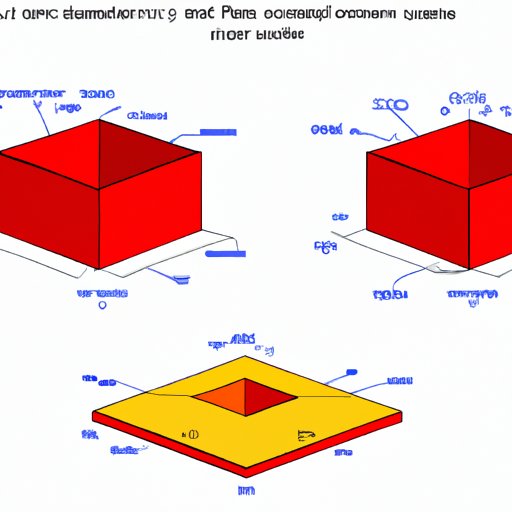Introduction
Surface area is a crucial mathematical concept used to calculate the collective area of all the faces of a 3D object. This calculation is essential in fields such as engineering, architecture, and physics, where a thorough understanding of an object’s surface area is required. In this article, we will explore how to find surface area, starting with the basics and progressing to more complex concepts.
Basic Definitions and Explanation of Surface Area
Surface area is the sum of the areas of all the faces of a 3D object. It is different from volume, which measures the space occupied by an object and is calculated as the product of its length, width, and height. The formula for calculating the surface area of a 2D shape, such as a square or circle, is well-known. Still, the formula for calculating the surface area of a 3D shape is more complex, requiring an understanding of the object’s faces, edges, and vertices.
Step-by-Step Guide to Finding Surface Area
To find the surface area of an object, follow these steps: identify the object’s faces, divide the object into simpler shapes, calculate the area of each shape, and sum the areas to obtain the total surface area. For simple 2D shapes, the area can be calculated using the formulas we learned in elementary school.
For more complex 3D shapes, the process is slightly more complicated. To calculate surface area for objects like cubes, cylinders, cones, and spheres, there are specific formulas to follow. It’s essential to know how to identify and count each face of the object, without missing any, and to find its area accurately.
Real-life applications of surface area calculations include calculating the amount of paint needed to cover a wall, determining the amount of wrapping paper needed to cover a gift, and calculating the amount of sheet metal needed to fabricate a cylinder.
Real-Life Examples of Finding Surface Area
In this section, we will explore some examples of everyday objects and how to find their surface area. For example, let’s take a cube with edges that measure eight centimeters. The total surface area of this cube is 384 square centimeters. To find this number, we use the formula:
Surface area of a cube = 6 x a², where a is the length of one edge of the cube.
We can also apply these formulas to more complex objects like cylinders and cones. The formula for the surface area of a cone is:
Surface area of a cone = πrs + πr², where r is the radius of the base of the cone, and s is the slant height of the cone.
Breaking down more complex shapes into simpler shapes and applying the relevant formulas is the key to accurately calculating surface area.
Infographics That Show How to Find Surface Area
The use of infographics is a powerful tool in explaining mathematical concepts such as surface area. A visually appealing infographic can help readers remember formulas and equations. Comparing the surface areas of different shapes in relative terms can help readers understand the concept of surface area better.
Video Tutorials That Walk Through the Process
Video tutorials provide a hands-on approach to learning, perfect for those who prefer a more immersive approach to education. In these videos, the viewer is walked through the process of finding surface area, using visual aids to enhance comprehension. Specific formulas and procedures are explained in detail, ensuring that viewers can solve even the most complex problems.
Common Mistakes to Avoid When Finding Surface Area
Common mistakes when calculating surface area include misidentifying the object’s faces, edges, and vertices, forgetting to include all faces of the object, and making computational errors. To avoid these mistakes, it’s vital to take your time, double-check your work, and practice iterative problem-solving.
Interactive Practice Exercises
Interactive practice exercises provide a useful platform for readers to test their understanding of surface area calculations. Mock objects and models are useful tools to allow for immersive learning, and explanations of the solutions to each of the practice exercises will help readers solidify their knowledge.
Conclusion
In conclusion, this article provides a step-by-step guide on how to find surface area. We have explored basic definitions and explained the difference between surface area and volume. We have offered a step-by-step approach to finding surface area, including detailed examples of real-life objects and how to calculate their surface areas. Infographics and video tutorials provide alternative methods of learning, while interactive practice exercises allow the user to test their knowledge in a hands-on environment.
It is essential to understand surface area in various industries, and we hope this guide has provided a useful introduction to the topic. With the right approach and sufficient practice, anyone can become an expert in finding surface area.
